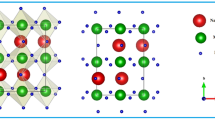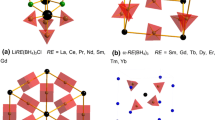Abstract
Metal hydrides are feasible for energy storage applications as they are able to decompose with hydrogen gas release. In this work, gaseous complex sodium hydrides, NaMH4 and Na2MH5 (M = B or Al), have been investigated using DFT/B3P86 and MP2 methods with 6-311++G(d,p) basis set; the optimized geometry, vibrational spectra and thermodynamic (TD) properties have been determined. Based on TD approach, a stability of the hydrides to different dissociation channels is analysed; the enthalpies of formation ∆fH°(0) of gaseous species have been obtained: − 1 ± 17 kJ mol−1 (NaBH4), 91 ± 14 kJ mol−1 (NaAlH4), − 13 ± 16 kJ mol−1 (Na2BH5), and 71 ± 16 kJ mol−1 (Na2AlH5). The complex hydrides are confirmed to produce gaseous products with hydrogen gas release at elevated temperature, whereas heterophase reactions, with NaH and B/Al products in condensed state, are predicted to occur spontaneously at lower temperature.

Graphical abstract









Similar content being viewed by others
References
Mustafa NS, Yahya MS, Sazelee N, Ali NA, Ismail M (2018) Dehydrogenation properties and catalytic mechanism of the K2NiF6-doped NaAlH4 system. ACS omega 3:17100–17107. https://doi.org/10.1021/acsomega.8b02281
Rusman N, Dahari M (2016) A review on the current progress of metal hydrides material for solid-state hydrogen storage applications. Int J Hydrog Energy 41:12108–12126. https://doi.org/10.1016/j.ijhydene.2016.05.244
Pottmaier D, Baricco M (2015) Materials for hydrogen storage and the Na-Mg-BH system. AIMS Energy 3:75–100. https://doi.org/10.3934/energy.2015.1.75
Zhang L, Yan N, Yao Z, Sun Z, Lu X, Nyahuma FM, Zhu R, Tu G, Chen L (2020) Remarkably improved hydrogen storage properties of carbon layers covered nanocrystalline Mg with certain air stability. Int J Hydrog 45:28134–28143. https://doi.org/10.1016/j.ijhydene.2020.03.170
Ouyang L, Liu F, Wang H, Liu J, Yang X-S, Sun L, Zhu M, Compounds (2020) Magnesium-based hydrogen storage compounds: A review. J Alloys 832:154865. https://doi.org/10.1016/j.jallcom.2020.154865
Züttel A, Rentsch S, Fischer P, Wenger P, Sudan P, Mauron P, Emmenegger C (2003) Hydrogen storage properties of LiBH4. J Alloys Compd 356:515–520. https://doi.org/10.1016/S0925-8388(02)01253-7
Ley MB, Jepsen LH, Lee Y-S, Cho YW, Von Colbe JMB, Dornheim M, Rokni M, Jensen JO, Sloth M, Filinchuk YJMT (2014) Complex hydrides for hydrogen storage–new perspectives. Mater Today 17:122–128. https://doi.org/10.1016/j.mattod.2014.02.013
Saitoh H, Takagi S, Matsuo M, Iijima Y, Endo N, Aoki K, Orimo S-i (2014) Li4FeH6: iron-containing complex hydride with high gravimetric hydrogen density. APL Materials 2:076103. https://doi.org/10.1063/1.4886219
Gasnier A, Amica G, Juan J, Troiani H, Gennari FC (2019) N-doped graphene-rich aerogels decorated with nickel and cobalt nanoparticles: effect on hydrogen storage properties of nanoconfined LiBH4. J Phys Chem 124:115–125. https://doi.org/10.1021/acs.jpcc.9b09510
Kumar D, Krishnamurty S, Pal SJTJPCC (2017) Dissociative adsorption of molecular hydrogen on BN-doped graphene-supported aluminum clusters. J Phys Chem C 121:26493–26498. https://doi.org/10.1021/acs.jpcc.7b07789
Li J, Li B, Shao H, Li W, Lin H (2018) Catalysis and downsizing in Mg-based hydrogen storage materials. Catalysts 8:89. https://doi.org/10.3390/catal802008
Zhang F, Wang Y, Chou M (2011) Theoretical study of the vibrational properties of NaAlH4 with AlH3 vacancies. Faraday Discuss 151:243–251. https://doi.org/10.1039/C0FD00012D
Li B, Li J, Zhao H, Yu X, Shao H (2019) Mg-based metastable nano alloys for hydrogen storage. Int J Hydrog Energy 44:6007–6018. https://doi.org/10.1016/j.ijhydene.2019.01.127
El Khatabi M, Bhihi M, Naji S, Labrim H, Benyoussef A, El Kenz A, Loulidi M (2016) Study of doping effects with 3d and 4d-transition metals on the hydrogen storage properties of MgH2. Int J Hydrog Energy 41:4712–4718. https://doi.org/10.1016/j.ijhydene.2016.01.001
Dovgaliuk I, Le Duff CS, Robeyns K, Devillers M, Filinchuk Y (2015) Mild dehydrogenation of ammonia borane complexed with aluminum borohydride. Chem Mater 27:768–777. https://doi.org/10.1021/cm503601h
Bogdanović B, Brand RA, Marjanović A, Schwickardi M, Tölle J (2000) Metal-doped sodium aluminium hydrides as potential new hydrogen storage materials. J Alloys Compd 302:36–58. https://doi.org/10.1016/S0925-8388(99)00663-5
Orimo S-i, Nakamori Y, Eliseo JR, Züttel A, Jensen CM (2007) Complex hydrides for hydrogen storage. Chem Rev 107:4111–4132. https://doi.org/10.1021/cr0501846
Oliveira AC, Pavão A (2018) Theoretical study of hydrogen storage in metal hydrides. J Mol Model 24:127. https://doi.org/10.1007/s00894-018-3661-4
Graetz J (2012) Metastable metal hydrides for hydrogen storage. International Scholarly Research Notices 2012. 10.5402/2012/863025
Maatallah M, Cherqaoui D, Jarid A, Liebman JF (2012) Large gallanes and the PSEPT theory: a theoretical study of GanHn+2 clusters (n= 7–9). J Mol Model 18:3321–3328. https://doi.org/10.1007/s00894-011-1335-6
Yang J, Sudik A, Wolverton C, Siegel DJ (2010) High capacity hydrogen storage materials: attributes for automotive applications and techniques for materials discovery. Chem Soc Rev 39:656–675. https://doi.org/10.1039/B802882F
Lototskyy M, Yartys V, Pollet B, Bowman Jr R (2014) Metal hydride hydrogen compressors: a review. Int J Hydrog Energy 39:5818–5851. https://doi.org/10.1016/j.ijhydene.2014.01.158
Chen P, Zhu M (2008) Recent progress in hydrogen storage. Mater Today 11:36–43. https://doi.org/10.1016/S1369-7021(08)70251-7
Jena P (2011) Materials for hydrogen storage: past, present, and future. The Journal of Physical Chemistry Letters 2:206–211. https://doi.org/10.1021/jz1015372
Bhuiya MMH, Lee CY, Hwang T, Munira S, Hopkins R, Yoon H, Park SH, Kim KJ (2014) Experimentally tuned dual stage hydrogen compressor for improved compression ratio. Int J Hydrog Energy 39:12924–12933. https://doi.org/10.1016/j.ijhydene.2014.05.186
Sundqvist B. (2009). Pressure-temperature phase relations in complex hydrides. Paper presented at the Solid State Phenomena
Wang G (2016) DFT investigations of hydrogen storage materials. Thesis
Baricco M, Palumbo M, Pinatel E, Corno M, Ugliengo P. (2010). Thermodynamic database for hydrogen storage materials. Paper presented at the Advances in Science and Technology
y De Dompablo MA, Ceder G (2004) First principles investigations of complex hydrides AMH4 and A3MH6 (A= Li, Na, K, M= B, Al, Ga) as hydrogen storage systems. J Alloys Compd 364:6–12. https://doi.org/10.1016/S0925-8388(03)00522-X
Chakrabarti S, Biswas K (2017) Effect on specific capacity and de-hydrogenation efficiency in doped-MgH2. Int J Hydrog Energy 42:327–339. https://doi.org/10.1016/j.ijhydene.2016.12.118
Pasini JM, Corgnale C, van Hassel BA, Motyka T, Kumar S, Simmons KL (2013) Metal hydride material requirements for automotive hydrogen storage systems. Int J Hydrog Energy 38:9755–9765. https://doi.org/10.1016/j.ijhydene.2012.08.112
Delmelle R, Gehrig JC, Borgschulte A, Züttel A (2014) Reactivity enhancement of oxide skins in reversible Ti-doped NaAlH4. AIP Adv 4:127130. https://doi.org/10.1063/1.4904428
Unemoto A, Matsuo M, Orimo Si (2014) Complex hydrides for electrochemical energy storage. Adv Funct Mater 24:2267–2279. /abs/https://doi.org/10.1002/adfm.201303147
Walters RT, Scogin JH (2004) A reversible hydrogen storage mechanism for sodium alanate: the role of alanes and the catalytic effect of the dopant. J Alloys Compd 379:135–142. https://doi.org/10.1016/j.jallcom.2004.04.155
Bogdanović B, Schwickardi M (1997) Ti-doped alkali metal aluminium hydrides as potential novel reversible hydrogen storage materials. J Alloys Compd 253:1–9. https://doi.org/10.1016/S0925-8388(96)03049-6
Spoliti M, Sanna N, Di Martino V (1992) Ab initio study on the MBF4 and MAlF4 molecules. J Mol Struct THEOCHEM 258:83–107. https://doi.org/10.1016/0166-1280(92)85034-I
Srinivasan SS, Sharma PC (2012) Enhancement of hydrogen storage behavior of complex hydrides via bimetallic nanocatalysts doping. Catalysts 2:434–446. https://doi.org/10.3390/catal2040434
Zaluska A, Zaluski L, Ström-Olsen J (2000) Sodium alanates for reversible hydrogen storage. J Alloys Compd 298:125–134. https://doi.org/10.1016/S0925-8388(99)00666-0
Orimo S-I, Nakamori Y, Kitahara G, Miwa K, Ohba N, Towata S-i, Züttel A (2005) Dehydriding and rehydriding reactions of LiBH4. J Alloys Compd 404:427–430. https://doi.org/10.1021/cr0501846
Ojwang J, van Santen R, Kramer GJ, Ke X (2008) An ab initio study of possible pathways in the thermal decomposition of NaAlH4. J Solid State Chem 181:3037–3043. https://doi.org/10.1016/j.jssc.2008.08.010
Tsere MH, Pogrebnaya TP, Pogrebnoi AM (2015) Complex hydrides Li2MH5 (M= B, Al) for hydrogen storage application: theoretical study of structure, vibrational spectra and thermodynamic properties. International Journal of Computational and Theoretical Chemistry 3:58–67. https://doi.org/10.11648/j.ijctc.20150306.13
Wang J-q, Gao J-f, Wu Z-g, Ou G-l, Wang Y (2015) Synthesis of renewable energy materials, sodium aluminum hydride by grignard reagent of Al. J Nanomater 2015:1–5. https://doi.org/10.1155/2015/296486
Andreasen A (2004) Predicting formation enthalpies of metal hydrides. Publishe, Denmark
Granovsky AA. Firefly version 8.1.0. http://classic.chem.msu.su/gran/firefly/index.html
Schmidt MW, Baldridge KK, Boatz JA, Elbert ST, Gordon MS, Jensen JH, Koseki S, Matsunaga N, Nguyen KA, Su S (1993) General atomic and molecular electronic structure system. J Comput Chem 14:1347–1363. https://doi.org/10.1002/jcc.540141112
Zhurko GA, Zhurko DA. Chemcraft version 1.7 (build 132). HTML: www.chemcraftprog.com
Tokarev KL. “OpenThermo” v.1.0 Beta 1 (C) ed., 2007-2009. http://openthermo.software.informer.com/
Wang J-q, Gao J-f, Wu Z-g, Ou G-l, Wang Y (2015) Synthesis of renewable energy materials, sodium aluminum hydride by grignard reagent of Al. J Nanomater 2015:1–5. https://doi.org/10.1155/2015/296486
Gurvich LV, S YV, Bergman GA, V VI, Gusarov AV, Iorish VS, Leonidov VY, Medvedev VA, Belov GV, Aristova NM, Gorokhov LN, Dorofeeva OV, Ezhov YS, Efimov M. E., Krivosheya NS, Nazarenko II, Osina EL, Ryabova VG, Tolmach PI, Chandamirova NE, Shenyavskaya EA Thermodynamic Properties of individual Substances. Ivtanthermo for Windows Database on Thermodynamic Properties of Individual Substances and Thermodynamic Modeling Software, Version 3.0, Version (Glushko Thermocenter of RAS, Moscow, 1992-2000)
Grochala W, Edwards PP (2004) Thermal decomposition of the non-interstitial hydrides for the storage and production of hydrogen. Chem Rev 104:1283–1316. https://doi.org/10.1021/cr030691s
Author information
Authors and Affiliations
Contributions
There were equal contributions of the authors to the completion of this work.
Corresponding author
Additional information
Publisher’s note
Springer Nature remains neutral with regard to jurisdictional claims in published maps and institutional affiliations.
Rights and permissions
About this article
Cite this article
Tsere, M.H., Pogrebnaya, T.P. & Pogrebnoi, A.M. Gaseous complex hydrides NaMH4 and Na2MH5 (M = B, Al) as hydrogen storage materials: a quantum chemical study. J Mol Model 27, 2 (2021). https://doi.org/10.1007/s00894-020-04601-3
Received:
Accepted:
Published:
DOI: https://doi.org/10.1007/s00894-020-04601-3




